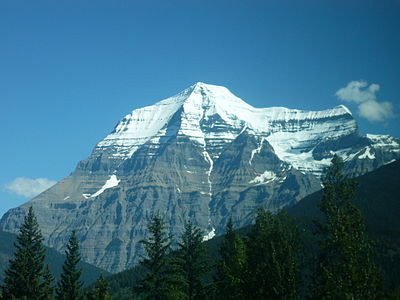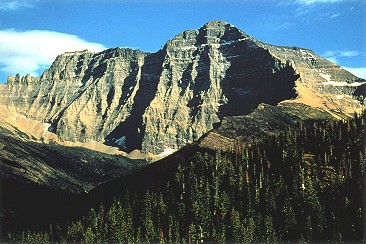List of the major 100-kilometer summits of the Rocky Mountains

The following sortable table lists the 19 peaks of the Rocky Mountains of North America with at least 100 kilometers (62.14 miles)* of topographic isolation and at least 500 meters (1640 feet)* of topographic prominence.[1]
The summit of a mountain or hill may be measured in three principal ways:
- The topographic elevation of a summit measures the height of the summit above a geodetic sea level.[2][3]
- The topographic prominence of a summit is a measure of how high the summit rises above its surroundings.[4][3]
- The topographic isolation (or radius of dominance) of a summit measures how far the summit lies from its nearest point of equal elevation.[5]
Major 100-kilometer summits
Of these 19 major 100-kilometer summits of the Rocky Mountains, six are located in Montana, four in Wyoming, three in Colorado, three in British Columbia, two in Utah, two in Alberta, and one in Idaho. Two of these peaks lie on the Alberta-British Columbia border.
Gallery
-
1. Mount Elbert in the Sawatch Range is the highest summit of the Rocky Mountains and the U.S. State of Colorado.
-
3. Mount Robson in British Columbia is the highest summit of the Canadian Rockies and the most prominent summit of the Rocky Mountains.
-
6. Cloud Peak is the highest summit of the Big Horn Mountains of Wyoming.
-
7. Blanca Peak is the highest summit of the Sangre de Cristo Mountains of Colorado.
-
8. Mount Cleveland is the highest summit of the Lewis Range of Montana.
-
9. Mount Columbia on the Great Divide between Alberta and British Columbia is the highest point of the Canadian Province of Alberta.
-
10. Mount Assiniboine on the Great Divide between Alberta and British Columbia is the highest summit of the Southern Continental Ranges.
-
12. Uncompahgre Peak is the highest summit of the San Juan Mountains of Colorado.
-
14. McDonald Peak is the highest summit of the Mission Mountains of Montana.
-
18. Grand Teton is the highest summit of the Teton Range of Wyoming.
See also
- Rocky Mountains
- List of mountain peaks of North America
- List of mountain peaks of Greenland
- List of mountain peaks of Canada
- List of mountain peaks of the Rocky Mountains
- List of the major 4000-meter summits of the Rocky Mountains
- List of the major 3000-meter summits of the Rocky Mountains
- List of the ultra-prominent summits of the Rocky Mountains
- List of the major 100-kilometer summits of the Rocky Mountains
- List of extreme summits of the Rocky Mountains
- List of mountain peaks of the United States
- List of mountain peaks of México
- List of mountain peaks of Central America
- List of mountain peaks of the Caribbean
- Physical geography
References
- ^ This article defines a significant summit as a summit with at least 100 meters (328.1 feet)* of topographic prominence, and a major summit as a summit with at least 500 meters (1640 feet)* of topographic prominence. All summits in this article have at least 500 meters of topographic prominence. An ultra-prominent summit is a summit with at least 1500 meters (4921 feet)* of topographic prominence.
- ^ All elevations in the 48 states of the contiguous United States include an elevation adjustment from the National Geodetic Vertical Datum of 1929 (NGVD 29) to the North American Vertical Datum of 1988 (NAVD 88). For further information, please see this United States National Geodetic Survey note.
- ^ a b If the elevation or prominence of a summit is calculated as a range of values, the arithmetic mean is shown.
- ^ The topographic prominence of a summit is the topographic elevation difference between the summit and its highest or key col to a higher summit. The summit may be near its key col or quite far away. The key col for Denali in Alaska is the Isthmus of Rivas in Nicaragua, 7642 kilometers (4749 miles)* away.
- ^ The topographic isolation of a summit is the great-circle distance to its nearest point of equal elevation.














